Capsicum chinense, also known as the “bonnet pepper” or “Scotch bonnet,” is a chili pepper originating in Central and South America. It is one of the five domesticated species of Capsicum peppers, along with C. annuum, C. frutescens, C. baccatum, and C. pubescens. Capsicum chinense is known for its distinctive spiciness, flavor, and unique shape. It is a popular ingredient in many cuisines worldwide, particularly in Caribbean and African dishes.
This article will explore everything you need to know about this fascinating pepper, from its history and cultivation to its culinary uses and health benefits. So grab a glass of milk and get ready to learn about the fiery Capsicum Chinense!
What is Capsicum Chinense?
Capsicum chinense is a chili pepper species belonging to the nightshade family, Solanaceae. It is believed to have originated in the Amazon basin and then spread throughout Central and South America. The name “Capsicum chinense” comes from its resemblance to Chinese peppers, although it has no known connection to China. This species includes many popular varieties, such as habaneros, Scotch bonnets, and ghost peppers.
Capsicum chinense plants are typically small to medium-sized shrubs that can grow up to 5 feet tall. They have a bushy growth habit, with dark green leaves and white flowers that eventually become distinctive peppers. The peppers vary in size, shape, and color, ranging from small and round to large and elongated and from green to red, orange, or yellow. Most Capsicum Chinense peppers are known for their intense spiciness, with some varieties reaching up to 1 million Scoville heat units (SHUs).
History and Origin of The Capsicum Chinense
It has a rich history and cultural significance. Archaeological evidence suggests that chili peppers have been consumed in Central and South America for over 9,000 years. It is believed to have originated in the Amazon basin and then spread throughout the region with the help of Native American trade routes. It was also a key ingredient in ancient Aztec cuisine and used in traditional medicinal practices.
The first European record of Capsicum chinense was made by Spanish explorer Francisco Hernández de Toledo in the 16th century, who encountered it during his travels to the New World. Today, it is widely cultivated in tropical and subtropical regions, with China being one of the top producers.
Capsicum chinense, one of the major species of chili peppers, has a name that is quite misleading in terms of its geographical origin. The species name “chinense” was assigned by the Dutch botanist Nikolaus Joseph von Jacquin in the 18th century. Interestingly, the name “chinense” or “Chinese” suggests a Chinese origin, but this is a misnomer.
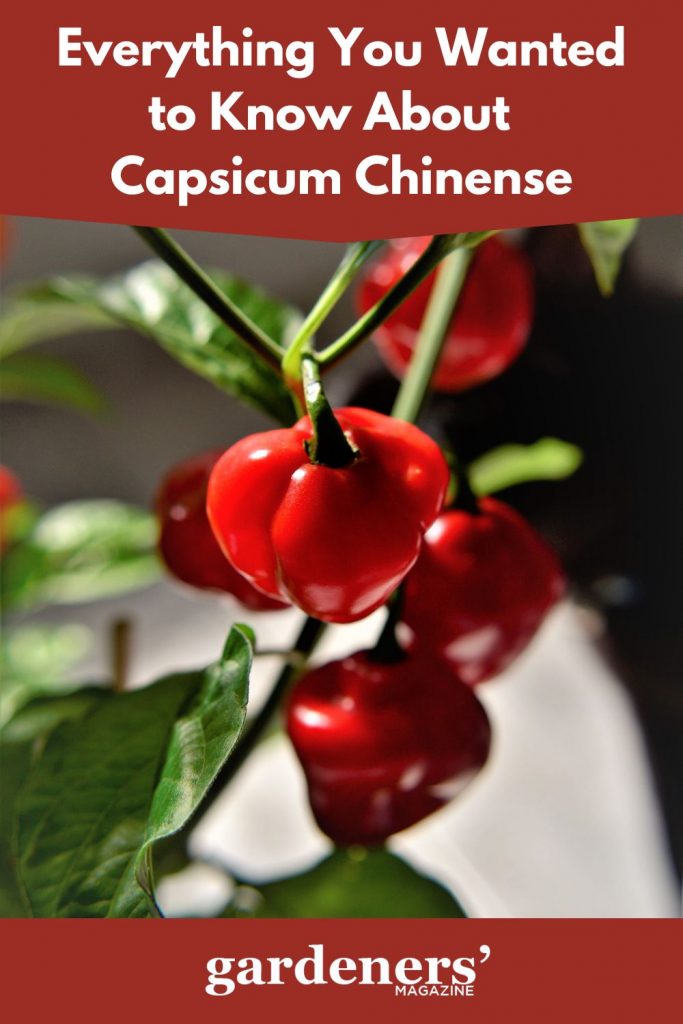
Characteristics of Capsicum Chinense
Appearance and Growth
Capsicum chinense plants are small shrubs that grow to about 3 feet tall. They have thin stems with dark green leaves that can range from 2-6 inches in length. The flowers are small and white, but the fruit makes this plant stand out. The fruits of Capsicum chinense grow upright and measure about 1-2 inches in length. They have a distinct lantern or bonnet shape, with a rounded top and tapered bottom. As they ripen, the fruits change from green to shades of red, orange, and yellow.
Heat Level
These are amongst the hottest chili peppers in the world, renowned for their intense spiciness. They typically range from 100,000 to 350,000 Scoville Heat Units (SHU), although some varieties can exceed 1,000,000 SHU. This scale measures the pungency (or spiciness) of chili peppers. To put this into perspective, a jalapeno pepper typically measures between 3,500 and 8,000 on the Scoville scale. This makes Capsicum chinense one of the hottest peppers in the world, along with other varieties such as the Carolina Reaper and Trinidad Moruga Scorpion.
Flavor Profile
Despite their extreme heat, these peppers offer complex flavor profiles beyond just spiciness. They often possess fruity, floral, or smoky undertones, adding depth to their taste. The flavor can vary between different cultivars, with some exhibiting citrusy notes while others have a more earthy or nutty taste. The fruity and floral notes make it a popular ingredient in salsas, hot sauces, and marinades.
Varieties of Capsicum Chinense Peppers
There are many varieties of Capsicum Chinense peppers, each with a unique flavor and heat level. Some popular varieties include Habanero, Scotch Bonnet, Ghost Pepper (Bhut Jolokia), and Trinidad Scorpion.
- Habanero: The classic Habanero pepper is one of the most well-known varieties of Capsicum chinense. It is small, lantern-shaped, and exceptionally hot, with a Scoville Heat Unit (SHU) rating ranging from 100,000 to 350,000.
- Scotch Bonnet: Similar in heat level to the Habanero, Scotch Bonnet peppers are slightly larger and have a distinctively squat, bonnet-like shape. They are commonly used in Caribbean cuisine and have a fruity, tropical flavor.
- Trinidad Moruga Scorpion: Known for its extreme heat, the Trinidad Moruga Scorpion held the Guinness World Record for the hottest chili pepper in 2012. It has a wrinkled appearance and a blistering heat level that can exceed 2,000,000 SHU.
- Carolina Reaper: Developed by Ed Currie of PuckerButt Pepper Company, the Carolina Reaper currently holds the title of the world’s hottest pepper. It has a distinctive, bumpy texture and a fiery heat that surpasses 2,200,000 SHU.
- Bhut Jolokia (Ghost Pepper): Originally from India, the Bhut Jolokia gained fame for its searing heat and was once considered the world’s hottest pepper. It has a wrinkled, elongated shape and a fruity, smoky flavor.
- Chocolate Habanero: As the name suggests, the Chocolate Habanero is a darker variant of the classic Habanero pepper. It has a rich, chocolate-brown color and a heat level similar to its orange counterpart.
- Fatalii: Originating from Central Africa, the Fatalii pepper is prized for its intense heat and citrusy flavor profile. It has a distinctive elongated shape and a vibrant yellow color when ripe.
- Yellow 7 Pot: Named for its ability to heat seven pots of stew, the Yellow 7 Pot pepper is native to Trinidad and Tobago. It has a wrinkled appearance and a vibrant yellow color, with heat levels exceeding 1,000,000 SHU.
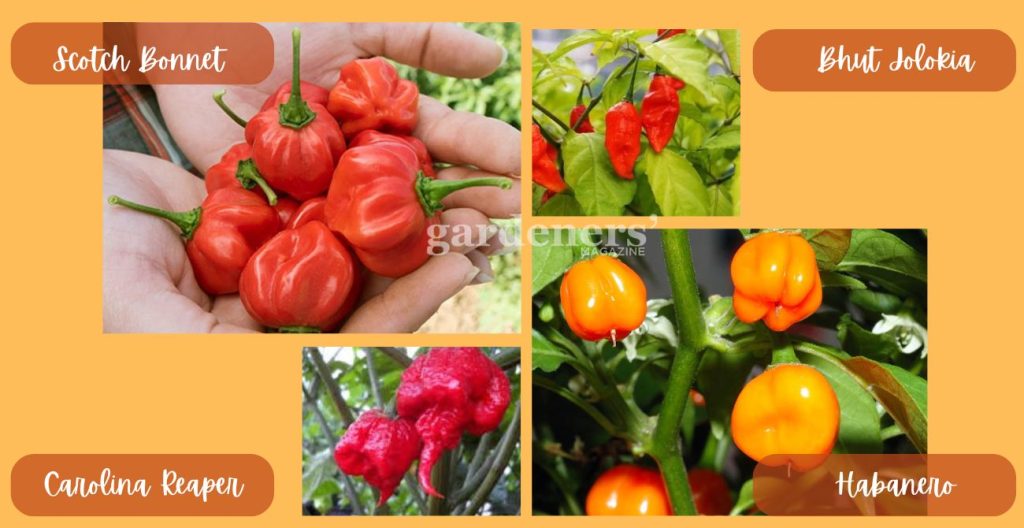
Seasonality and Availability Throughout the Year of Capsicum Chinense
Capsicum chinense is a tropical plant that thrives in warm and humid climates. It is believed to have originated in South America, specifically in the Amazon Basin region. Capsicum chinense plants can grow year-round in their natural environment, producing multiple fruit harvests.
However, for those living in temperate regions, it may be more difficult to grow and harvest outside of the summer months. The plants are sensitive to cold temperatures, and frost can damage or kill them. This means that it is primarily available during the summer season in these regions.
Fortunately, with the increasing popularity of hot peppers, they are now being grown in controlled environments such as greenhouses, allowing for a longer growing season and availability throughout the year. This has also made Capsicum chinense more accessible to consumers in colder regions who want to enjoy its unique flavor and heat.
Growing Conditions Required for Capsicum Chinense
It is closely related to other varieties, such as Capsicum annum and frutescens, but its physical characteristics and growing conditions are distinct.
Climate Requirements
Capsicum chinense grows best in tropical or subtropical climates, with temperatures ranging from 18-30 degrees Celsius. It is a perennial plant but is often grown annually due to its sensitivity to frost and cold temperatures. To thrive, it needs warm weather and plenty of sunshine.
Soil Requirements
The soil should be well-drained and slightly acidic, with a pH level between 5.5 and 6.5. It also thrives in rich, loamy soil with good organic matter content. The ideal soil should have a good moisture and air circulation balance to promote healthy root growth.
Spacing
Plant these peppers 18 to 24 inches apart in rows spaced 24 to 36 inches apart. Providing adequate spacing ensures good air circulation around the plants and reduces the risk of disease.
Watering Requirements
It requires regular watering but not excessive amounts that can lead to waterlogging and root rot. Watering frequency will depend on temperature, humidity, and soil moisture levels. Maintaining a consistent moisture level in the soil is important for optimal growth.
Fertilizer Requirements
Providing proper nutrients is crucial for the growth of Capsicum chinense. A balanced fertilizer with equal parts nitrogen, phosphorus, and potassium (N-P-K) can be applied every 2-3 weeks during the growing season. It is important to avoid overfertilizing, as it can lead to stunted growth and decreased fruit production.
Preparing for Planting Capsicum Chinense
Capsicum chinense, commonly known as the habanero pepper, is a popular hot pepper among gardeners and food enthusiasts. Known for its distinct fruity flavor and intense heat, it is often used in various cuisines around the world. If you plan to grow habanero peppers, here are some steps to help you prepare for a successful planting season.
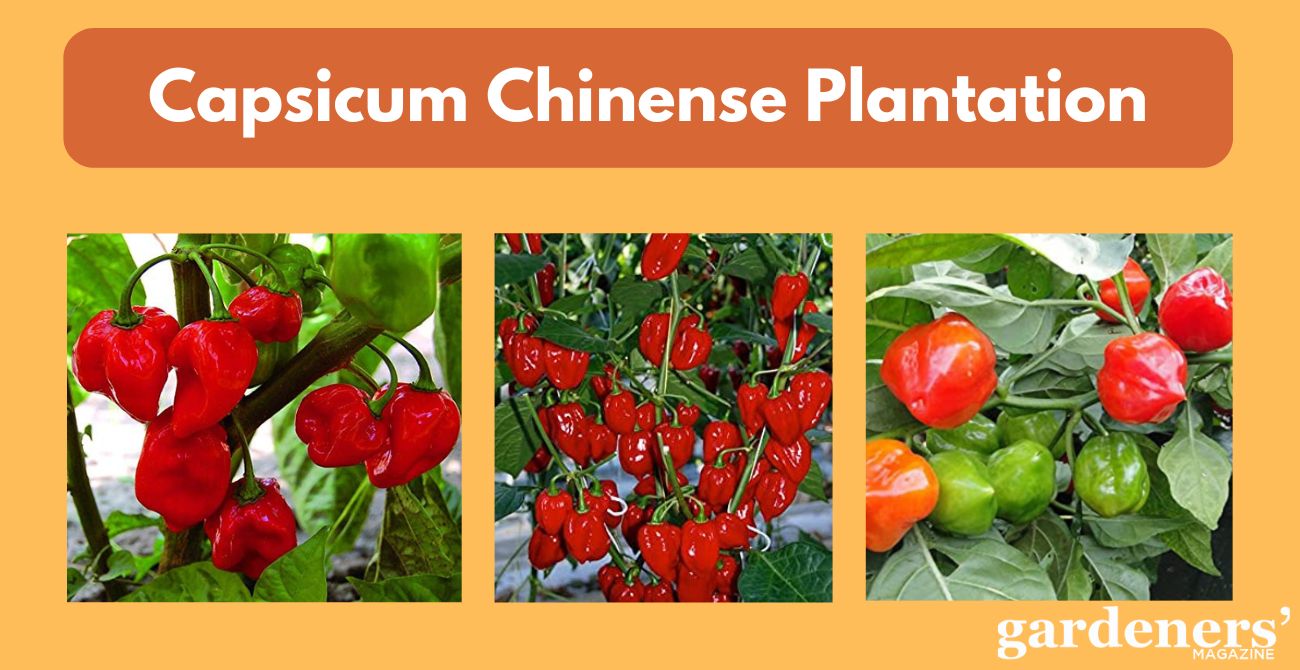
Choosing the Right Location
The first step in preparing to plant this pepper is choosing the right location. Habanero peppers thrive in warm and sunny environments, so choosing a spot in your garden that receives at least 6 hours of direct sunlight daily is best. They also prefer well-drained soil that is rich in organic matter. If your garden does not have ideal conditions, consider using raised beds or containers to ensure optimal growing conditions for your habanero peppers.
Soil Preparation
Before planting, preparing the soil to provide the best growing environment for your habanero peppers is important. Start by testing the soil’s pH level, as Capsicum chinense prefers a slightly acidic soil with a pH of 5.5 to 6.5. If your soil is too alkaline, you can amend it with sulfur or peat moss to lower the pH level. Add compost or well-rotted manure to the soil to increase its nutrient content, which is also recommended.
Starting Seeds Indoors
Habanero peppers are a warm-weather crop and take longer to mature than other pepper varieties. To get a head start on the growing season, it is best to start your habanero pepper seeds indoors. Start
them in small containers with well-draining soil and place them in a warm location, preferably around 80°F. Keep the soil evenly moist but not overly wet. Once the seedlings have developed 2-3 leaves, you can transplant them outdoors.
Transplanting Outdoors
After the last frost has passed and your habanero pepper seedlings have grown to about 6 inches in height, it is time to transplant them outdoors. Choose a calm and cloudy day to prevent shock to the
plants from harsh sunlight and wind. Dig a hole twice the size of the root ball and place your seedlings in it, ensuring the top of the root ball is level with the soil surface. Firmly pack the soil around the plant and give it a good watering.
Caring For Capsicum Chinense
In this section, we will discuss how to properly care for Capsicum chinense plants so that you can enjoy a bountiful harvest of hot peppers.
Watering
Like most plants, Capsicum chinense requires regular watering to stay healthy and produce fruits. However, over-watering can lead to root rot and other diseases, so it is important to find the right balance.
Generally, these plants should be watered every 2-3 days or when the top inch of soil feels dry. During hot and dry weather, they may require more frequent watering. It is best to avoid getting the leaves wet when watering, as this can increase the risk of fungal diseases.
Fertilizing
Capsicum chinense plants benefit from regular fertilization, especially during the growing season. A balanced fertilizer with equal amounts of nitrogen, phosphorus, and potassium is ideal for these plants.
Fertilizer should be applied every 2-3 weeks, starting when the plant begins to flower. Be careful not to over-fertilize, leading to excessive foliage growth and decreased fruit production.
Capsicum chinense plants are generally resistant to pests and diseases, but it is still important to monitor them regularly. Some common pests that may attack these plants include aphids, mites, and thrips. These can be controlled with insecticidal soap or neem oil.
Mulching
Mulching is a beneficial practice for Capsicum chinense plants as it helps to retain moisture in the soil, suppress weeds, and regulate soil temperature. A layer of organic mulch, such as straw or shredded leaves, should be applied around the base of the plant.
It is important not to let the mulch touch the stems of the plants as this can create a damp environment that can lead to fungal diseases. Mulch should also be replenished regularly as it decomposes over time.
Pruning
Pruning can help promote a more compact and bushy growth habit in Capsicum chinense plants. It is best to prune the plants when they are young, removing any suckers or lateral branches that may compete with the main stem for nutrients and energy.
Pruning should also be done to remove any damaged or diseased branches, as well as to increase air circulation within the plant. This can help prevent fungal diseases and promote better fruit production.
Support
Some varieties of Capsicum chinense can grow quite tall and may require support to prevent them from toppling over. This is especially important when the plants start producing heavy fruit.
Tall stakes or cages can be used to provide support for the plants. Installing these supports early on in the plant’s growth is best to avoid damaging the roots later on.
Pest and Disease Management
Capsicum chinense plants can be susceptible to a variety of pests and diseases. Common pests affecting these plants include aphids, thrips, and whiteflies. These can be controlled using insecticidal soap or other organic pest management methods (like using eggshells) in the garden.
Fungal diseases such as powdery mildew and root rot can also be problematic for Capsicum chinense plants. Keeping the plants well-spaced and providing good air circulation can help prevent these diseases. Using a fungicide can also be effective in controlling fungal diseases.
Harvesting of Capsicum Chinense
The harvesting process begins with selecting the right time for harvesting. It is crucial to wait for the peppers to reach their desired level of ripeness before picking them. These peppers are usually harvested when fully mature and have turned bright red, orange, or yellow.
Choosing the Right Time
The timing of pepper harvest greatly affects its taste and quality, so choosing the right time for harvesting is essential. For Capsicum chinense, the ideal time to harvest is when the peppers have reached their full size and vibrant color.
If the peppers are at an early stage, they will have yet to develop their full flavor potential. On the other hand, if left on the plant for too long, they may become overripe and lose their firmness and crispiness.
Harvesting Methods
There are two main methods of harvesting these peppers: by hand or using tools. The method used depends on the scale of production and personal preference.
- Hand Harvesting: Hand harvesting is the most practical and efficient method for small-scale pepper production. It involves gently picking the ripe peppers off the plant using your hands. This method is preferred for high-value peppers, such as Capsicum chinense, to prevent any damage to the delicate fruit.
- Tool Harvesting: Hand harvesting may not be feasible for large-scale production, and tools are used instead. Tools such as pruning shears or scissors can cut the pepper stem near its base without damaging the fruit.
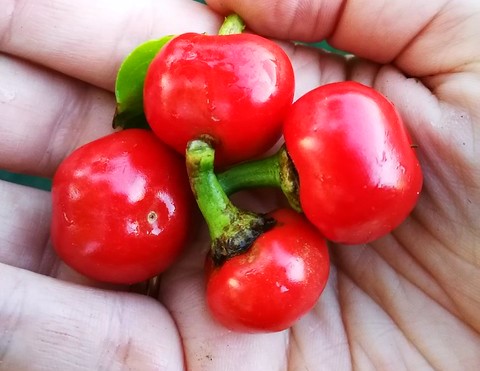
Caring For Your Peppers
Proper care of peppers after harvest is crucial to maintain their quality and extend their shelf life. Here are some tips for handling and storing your peppers:
-
- Handle the fruits gently to avoid any damage or bruising.
-
- Remove dirt or debris from the peppers by wiping them with a damp cloth.
-
- Sort out damaged or spoiled peppers and use them first to avoid any spoilage.
-
- Store the peppers in a cool, dry place with good air circulation to prevent mold growth.
-
- Avoid storing the peppers near ethylene-producing fruits, such as apples, as this can cause premature ripening and spoilage.
By following these tips, you can ensure that your Capsicum chinense peppers will stay fresh and retain their flavor for longer.
Growing Your Own Capsicum Chinense Peppers
If you want a steady supply of fresh Capsicum chinense peppers, consider growing them in your garden. These plants are relatively easy to grow and can be grown in containers or directly on the ground.
Start by purchasing seeds from a reputable source and planting them indoors several weeks before the last frost date in your area. Once the seedlings have sprouted and grown a few inches, transplant them into larger containers or the ground.
Capsicum chinense peppers thrive in warm temperatures and need full sun, well-draining soil, and regular watering. You can expect to harvest ripe peppers within 3-4 months with proper care.
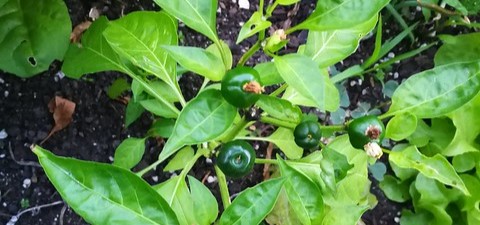
Storing of Capsicum Chinense
Here are a few options for Capsicum Chinense peppers:
Freezing
Capsicum chinense peppers can be frozen to prolong their shelf life. To freeze them, first wash and dry the peppers thoroughly. Then, remove the stem and seeds before cutting the pepper into desired sizes or leaving them whole. Place the pieces on a tray lined with parchment paper and freeze for about an hour until they are firm. After that, transfer the frozen pieces into an airtight container or freezer bag and store them in the freezer for up to 6 months. Frozen Capsicum chinense peppers can be used directly in cooking without thawing.
Drying
Another method of preserving Capsicum chinense peppers is by drying them. This can be done either by air-drying or using a dehydrator. To air-dry the peppers, string them together with a needle and thread them in a well-ventilated area. Depending on their size and humidity levels, it may take several weeks for the peppers to dry completely. Alternatively, you can use a dehydrator set at a low temperature to speed up the drying process. Once dried, store the peppers in an airtight container in a cool, dry place.
Pickling
Pickling is a popular method of preserving Capsicum chinense peppers, especially for those who enjoy the tangy and spicy flavor of pickled peppers. To pickle your peppers, first, wash and slice them into desired sizes before placing them in a jar with vinegar, water, salt, and spices of your choice. Allow the peppers to marinate in the pickling solution for at least a week before consuming them. Pickled Capsicum chinense peppers can be stored in the refrigerator for several months.
Canning
Canning is another method of preserving Capsicum chinense peppers that involves processing and sealing them in jars to prevent spoilage. To can your peppers, first, wash and slice them before blanching them in boiling water for a few minutes. Then, pack the peppers into clean and sterilized jars before adding a pickling solution or brine. Finally, process the jars in a water bath canner according to recommended times based on your altitude. Canned Capsicum chinense peppers can last up to one year when stored in a cool, dark place.
Uses of Capsicum Chinense
Aside from being used for their fiery heat, Capsicum chinense peppers also have a variety of culinary uses. They are commonly used in cooking to add heat and flavor to a variety of dishes. They can be used fresh, dried, or powdered to enhance the taste of sauces, salsas, marinades, curries, stews, and soups. These peppers are popular in spicy dishes from regions such as the Caribbean, Latin America, and parts of Africa and Asia.
They are often used to make hot sauces, chili pastes, and condiments like pepper jelly or relish. These products are enjoyed as toppings or accompaniments to various foods, including meats, sandwiches, and snacks.
Capsicum chinense peppers can be pickled or fermented to preserve them and develop complex flavors. Pickled peppers are commonly used as toppings for tacos, sandwiches, and salads, while fermented peppers are used to make hot sauces and kimchi.
Health Benefits of Capsicum Chinense
Medicinally, these are rich in vitamins A and C and capsaicin, a compound known for its anti-inflammatory and pain-relieving properties. It is also a great source of carotenoids. They have been used in traditional medicine to treat conditions such as arthritis, digestive issues, and even cancer. The fiber content in these peppers aids digestion and promotes gastrointestinal health by regulating bowel movements and preventing constipation. Additionally, capsaicin stimulates gastric juices and may improve digestion. It also helps lower blood pressure, reduce cholesterol levels, and improve circulation, thus supporting heart health.
Cautions When Handling Capsicum Chinense Peppers
As with any hot pepper, it’s important to take precautions when handling Capsicum chinense peppers. The capsaicin in these peppers can cause irritation and burning sensations on the skin, especially in sensitive areas such as the eyes and nose.
To avoid this, wearing gloves while handling them or washing your hands thoroughly after touching them is recommended. It’s also important to be careful when cutting and preparing these peppers, as the capsaicin can become airborne and cause irritation to the eyes and airways.
Conclusion
Capsicum chinense peppers are a popular source of heat and flavor in many cuisines and have beneficial medicinal properties. However, handling them with caution is important to avoid any potential irritation or discomfort. With proper handling and storage techniques, these peppers can be enjoyed for their unique taste and health benefits. So go ahead and add some spice to your dishes with Capsicum chinense peppers; remember to handle them with care.
So, always be mindful when working with these hot peppers and take the necessary precautions for a safe and enjoyable experience. Exploring different cuisines and using new ingredients can be exciting, but safety should always come first.
Before you leave, learn about the best gardening books that every gardener should read.
- Dino Melons: Description, Flavor, Benefits, And Uses - April 29, 2025
- Pear Trees: Planting, Growing, and Harvesting Pears - March 27, 2024
- Runner Beans (Scarlet Runner Bean): Description, Flavor, Benefits, And Uses - March 21, 2024

6 thoughts on “Everything You Wanted To Know About Capsicum Chinense ”
Comments are closed.